This post may contain affiliate links. Please see our disclosure policy for more details.
Serving shrimp to babies can be tricky. Follow these cooking tips, serving suggestions, and healthy recipes.
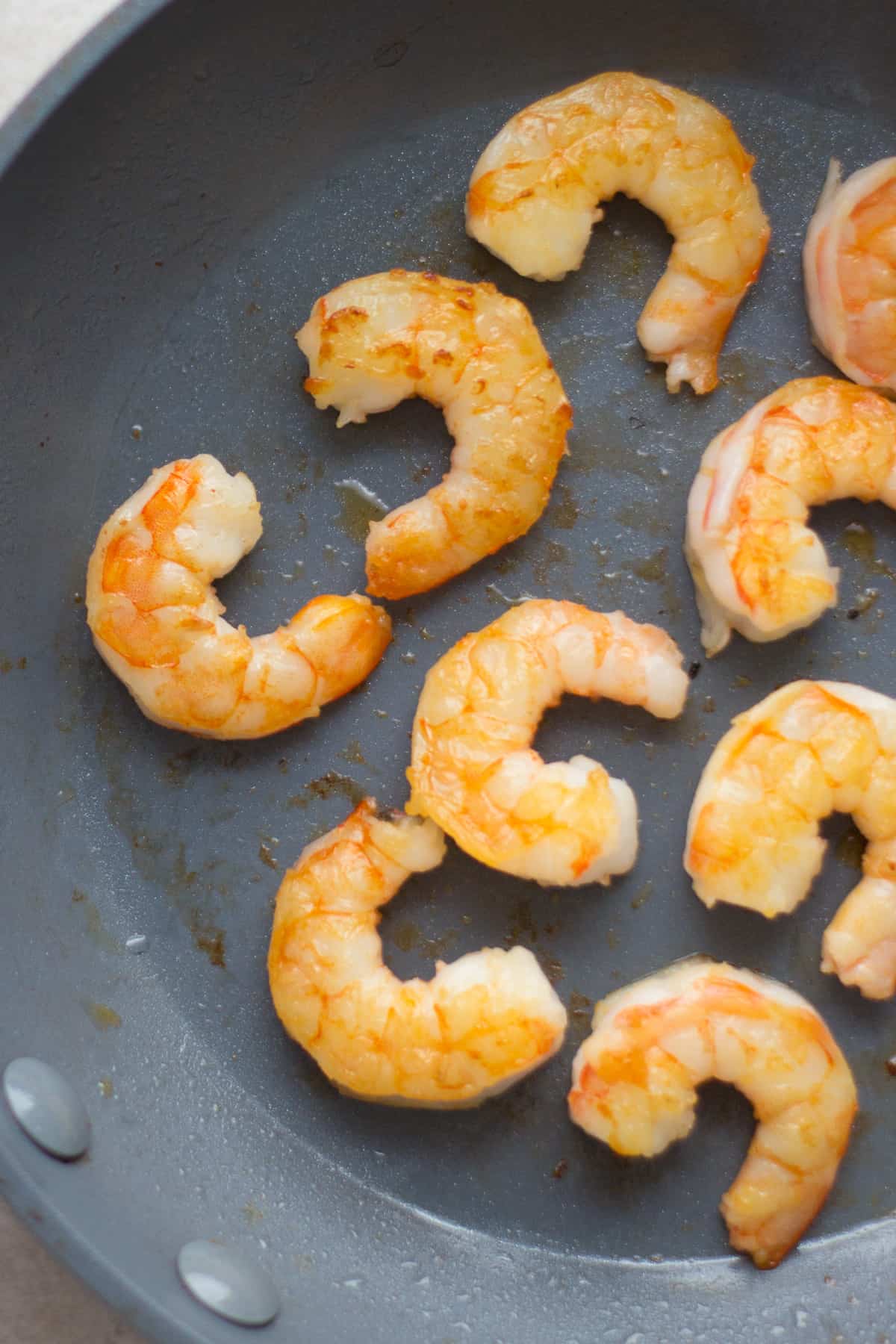
Table of Contents
When to introduce
Shrimp can be offered to babies as soon as they’re ready to start solids, usually around 6 months. It’s important to remember that your baby is unique and that rather than going by the calendar, you need to make sure your baby is DEVELOPMENTALLY ready to start solids.
If you’re unsure, be sure to grab my FREE handout!
Is shrimp safe for babies?
Its chewy and rubbery texture makes it hard for babies to handle and can lead to choking. But that doesn’t mean that you should avoid it all together, especially if your family enjoys shrimp or any other shellfish for that matter.
But be sure to cook the shrimp properly and serve in an age-appropriate way, which I am about to show you.
Also, shrimp and other shellfish are one of the top allergens, and if you were told to wait until around 2-3 years of age to introduce them, this is outdated advice!
The current recommendation is to introduce highly allergenic foods EARLY and OFTEN. By doing so, you can dramatically reduce the risk or actually help prevent the development of food allergies.
When first introducing, start with a small amount. Be sure it’s the only new food on your baby’s plate so that if there is an allergic reaction, you will know what caused it.
Serve it at home early in the day so you can monitor your baby for any reaction(s) and get medical help if necessary.
Note: If your baby is allergic to shellfish, it doesn’t necessarily mean they will be allergic to finned fish, as well. Same goes for different types of shellfish. Therefore, be sure to introduce all new fish and shellfish one at a time, just like you would tree nuts.
Health Benefits
Shrimp is a great source of protein as well as nutrients that support brain development, including omega-3 fatty acids, B12, and choline. It is also lower in mercury compared to other fish and shellfish.
However, enjoy in moderation as it is high in sodium. And shrimp are oftentimes treated with chemicals and antibiotics.
Here’s a list of best shrimp to purchase along with other seafood.
Shrimp Buying Guide
I don’t know about you, but with so many choices, buying shrimp can be quite confusing! So I hope this is helpful.
Wild-caught vs. Farmed Shrimp
Let’s talk about safety first. Farmed shrimp are grown in aquaculture ponds that require antibiotics and chemicals to control bacterial growth. They’re also injected with antibiotics and hormones.
Wild-caught shrimp are free from any of these.
However, the method by which shrimp are caught poses a threat to the wild fish populations and the overall ecosystem.
Something I learned during my research is that wild-caught US shrimp are the most highly regulated and harvested in a way that does not disturb their natural environment. They are also caught without using slave or forced labor, which is the case for many of the countries supplying shrimp.
All this to say, both types of shrimp have their benefits and flaws. The main takeaway is to enjoy shrimp with your family, including your baby.
But do strive for variety by enjoying other sustainable seafood that are available in your region. If possible, buying directly from local fishermen is always the best idea.
Fresh vs. Frozen
I personally purchase frozen. Here’s why. Most local grocery stores sell defrosted shrimp. While it may seem convenient, shrimp are highly perishable and once thawed, the quality and texture start to decline.
And there’s no way of knowing how they were thawed or for how long. After sitting for a couple of days, they become mushy and oftentimes that’s when they go on sale.
Frozen shrimp are sold either in block form or individually quick frozen (IQF). I buy the latter. I’ve learned that they are frozen shortly after being harvested and this process best preserves moisture, texture, and flavor.
It also allows me to thaw just what I need rather than having to thaw the entire package. Just make sure “shrimp” is the only ingredient listed.
What’s the best size?
A shrimp’s size is measured by the number of individual shrimp it takes to make up a pound. The smaller the number, the bigger the shrimp.
So 16/20, which is what I usually get, means there are 16-20 shrimp in a pound. Ignore labels like medium and jumbo as they’re not standardized and can vary greatly depending on the seller.
Head on or off?
Purchase headless, unless you can get your hands on live shrimp. The head contains enzymes that break down shrimp flesh once they die, resulting in a mushier texture.
Shelled?
Shells help seal in flavor and keep the shrimp moist. However, it’s a bit inconvenient to handle, isn’t it? If you’re adding to dishes, like pasta, rice, etc., I say purchase easy-to-peel or shelled. But if you’re grilling and serving on its own, shell-on is the better option.
How to Cook Shrimp for Babies
Here are the top four methods
Steamed
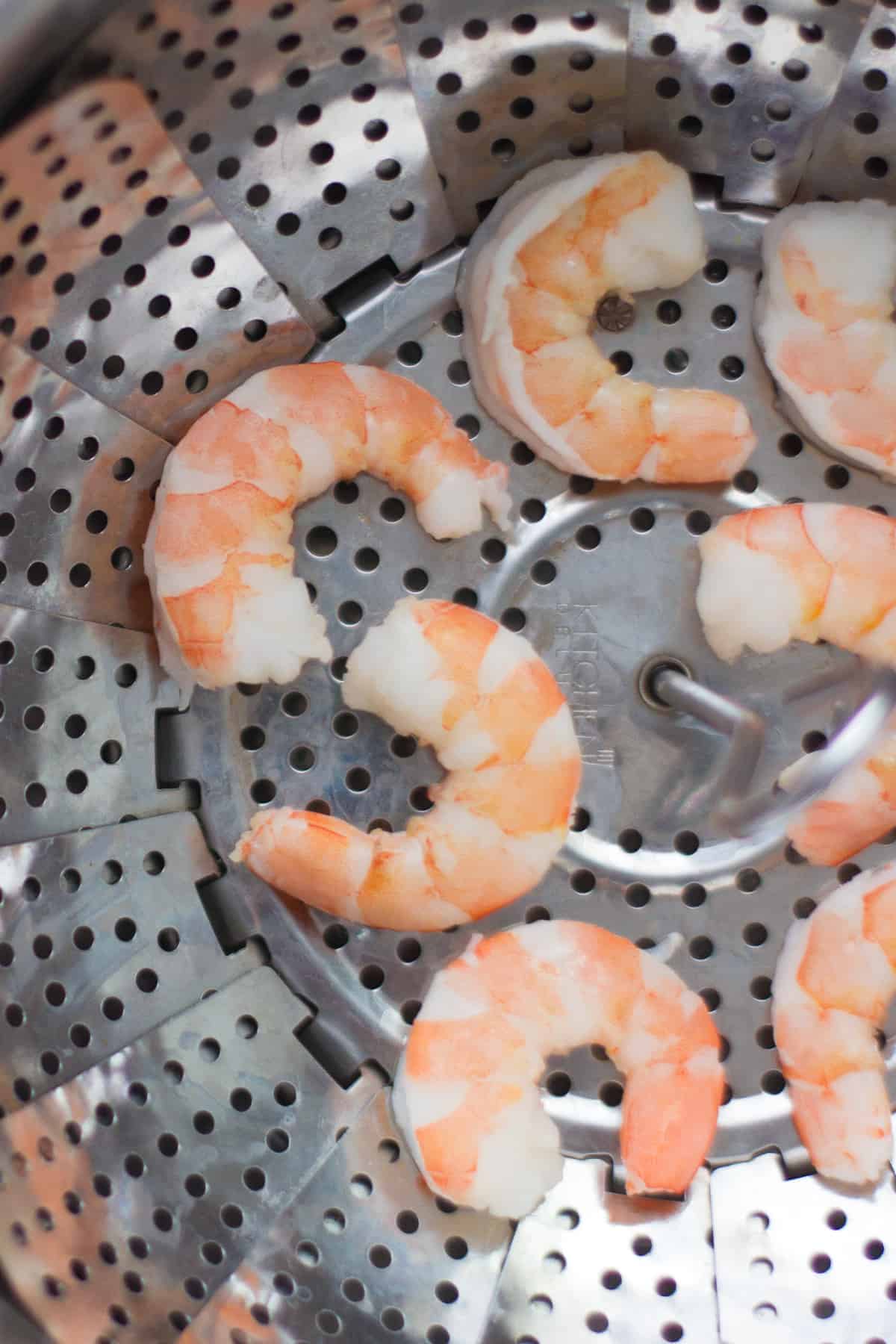
This is my favorite way to cook shrimp for babies.
Insert a steamer basket into a large pot. Fill with water to just below the steamer basket. Bring water to a boil.
Add shrimp to the pot and cover with a lid. Reduce heat to low and steam for 4-5 minutes.
Sauteed
Heat skillet over medium-high heat. Add olive oil or butter and once it begins to shimmer add the shrimp.
Once they start to turn pinkish on the bottom and curl, about 2-3 minutes, flip them over. Finish cooking until pink, opaque, and curled into a loose “C” shape, about 1-2 minutes. Immediately transfer to a plate to prevent overcooking.
Broiled
Turn the broiler on. Line a baking sheet with parchment paper or a baking mat and place shrimp on top in a single layer, making sure there’s space in between so they don’t touch.
Place on the top oven rack and broil for 2-3 minutes.
Baked
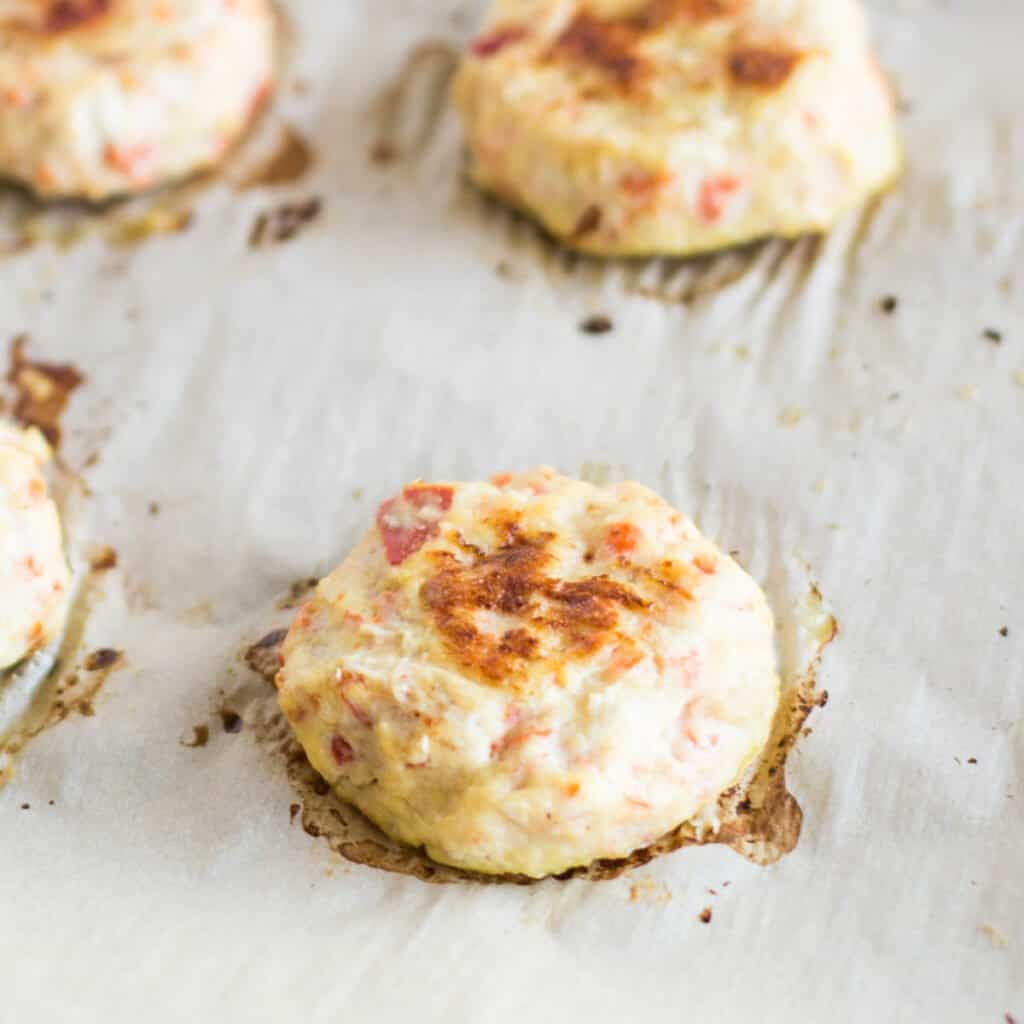
I personally love making shrimp cakes as they make for a wonderful finger food for babies and freeze beautifully!
Here’s a recipe you can try that is well-loved by many families around the world!
Boiled
While this is a common way to cook shrimp, I personally don’t recommend it as it’s so easy to overcook the shrimp. Not to mention, you can lose some of the shrimp flavor in the boiling water.
How to Serve for Baby Led Weaning
Once you’ve cooked the shrimp using any of the methods mentioned (except the cakes), be sure to finely mince and fold into foods.
By 8-9 months of age, your baby will be able to pick up small pieces. However, its tough texture makes it hard to chew so continue to finely chop or shred.
Here are some suggestions:
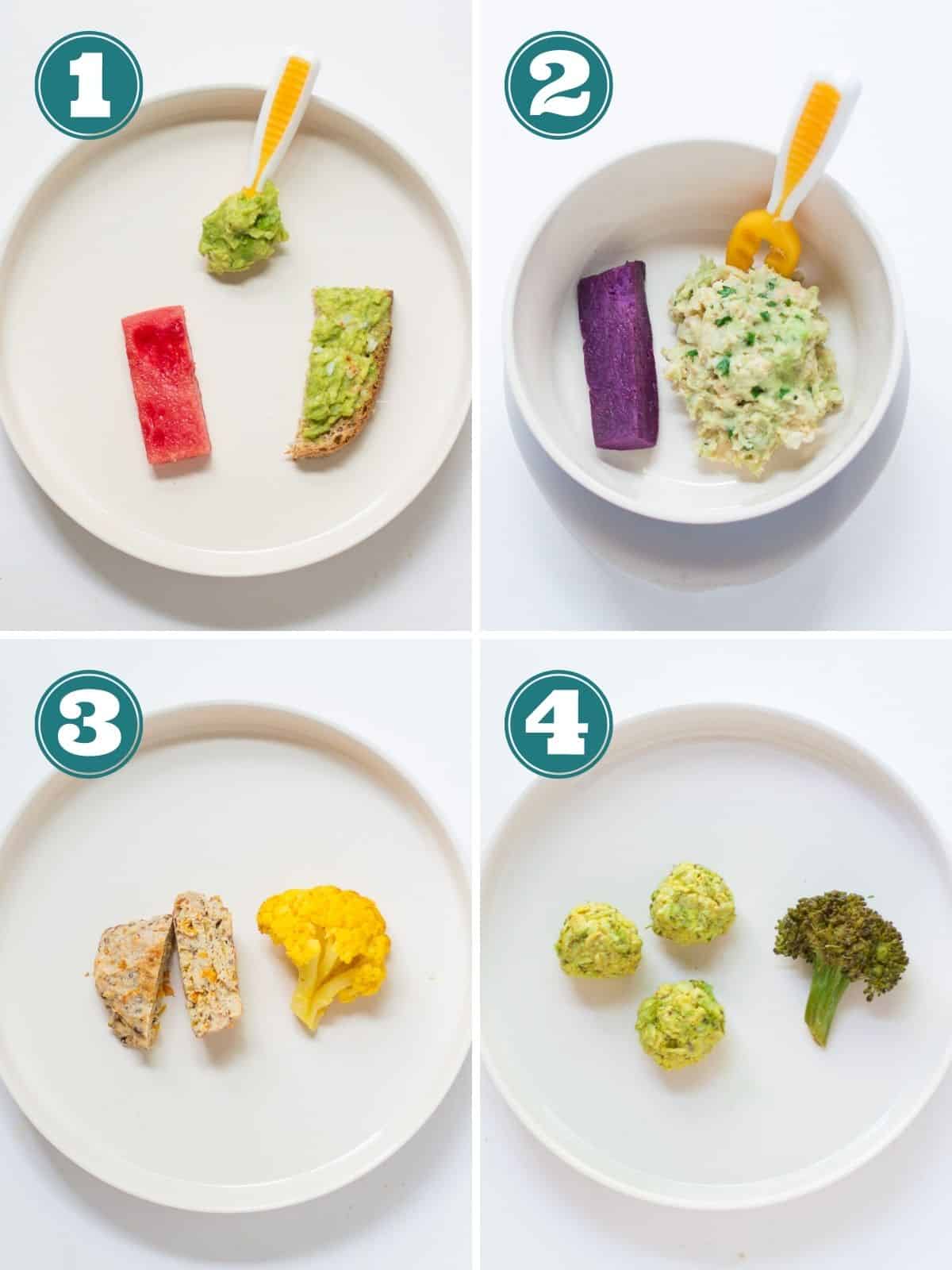
- Combine with mashed avocado and serve with a spoon or spread onto toast
- Combine with mashed beans (pictured: white beans) with herbs/spices (pictured: cumin and cilantro)
- Shrimp Cakes
- Add to oatmeal with vegetables (can shape into balls or fingers)
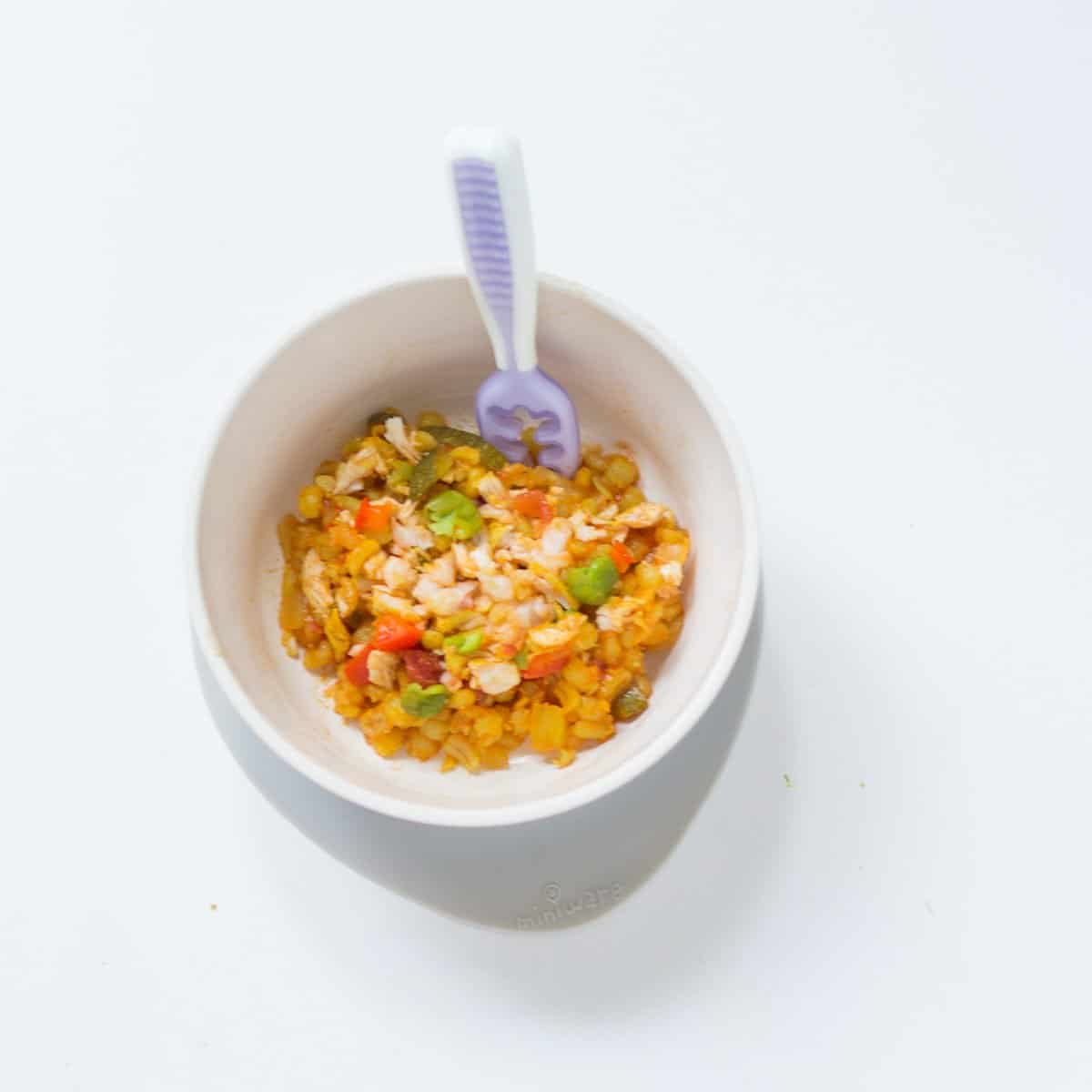
You can also add to family meals like this seafood paella (recipe from my One Pot Meals cookbook).
Frequently Asked Questions
If you’re planning ahead, thaw in the fridge overnight. But if you need a quick fix, take out of the bag and place in a bowl under COLD running water. They’ll be ready in just a few minutes! Warm water will alter their texture.
If you don’t want to let the water run, simply place in a bowl of cold water. It will take about twice as long using this method. Be sure to dry them on a paper towel before cooking
Here’s a general rule:
“U” shape means it’s underocoked
“O” shape means it’s overcooked
“C” shape means bingo! Perfectly cooked shrimp
Transfer to an airtight container and keep in the fridge for up to 3 to 4 days.
Additional Resource
Are you:
- getting ready to start or at the beginning stage of introducing solid solids and feeling overwhelmed?
- stuck on purees and having a really difficult time transitioning to table food?
- or tired of serving the same foods on repeat and want to offer more variety of foods to your older baby or toddler?
Here’s my 3 MONTH Baby Led Feeding Journey Program!
It’s a complete roadmap that would show you through daily videos and photos of what foods and how to serve them to your baby AND the rest of the family at the same time. Everything you need to know all in one place!

Do you want to minimize picky eating and set a solid foundation for a lifetime of healthy eating habits?
Check out this 3 month mastering self-feeding program! It’s the closest thing to me being in your kitchen
If you want to learn how to prepare other specific food(s), check out my How To Series!

How to Cook Shrimp For Babies
Equipment
Ingredients
- 1 pound (16 oz.) medium to large shrimp, fresh or thawed, if frozen
- 2 tablespoons oil or butter (if sauteeing or broiling)
Instructions
Steamed
- Insert a steamer basket into a large pot. Fill with water to just below the steamer basket. Bring water to a boil.
- Add shrimp to the pot and cover with a lid. Reduce heat to low and steam for 4-5 minutes, until they curl and turn pink. Turn once halfway through to ensure even cooking.
Sauteed
- Heat a large pan over medium high heat and add oil or butter. Swirl the pan around to coat the surface.
- Once it begins to shimmer add the shrimp. Flip when they turn pinkish on the bottom and curl, about 2-3 minutes. Finish cooking until pink, opque, and curled into a loose “C” shape, about 1-2 minutes. Immediately transfer to a plate to prevent overcooking.
Broiled
- Turn the broiler on. Line a baking sheet with parchment paper or a baking mat and place shrimp on top in single layer, making sure there's space in between so they don't touch.
- Place on the top oven rack and broil for 2-3 minutes.
Notes
- Once cooked, be sure to finely mince.
- Will keep in the refrigerator for 3-4 days.

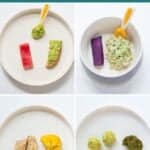



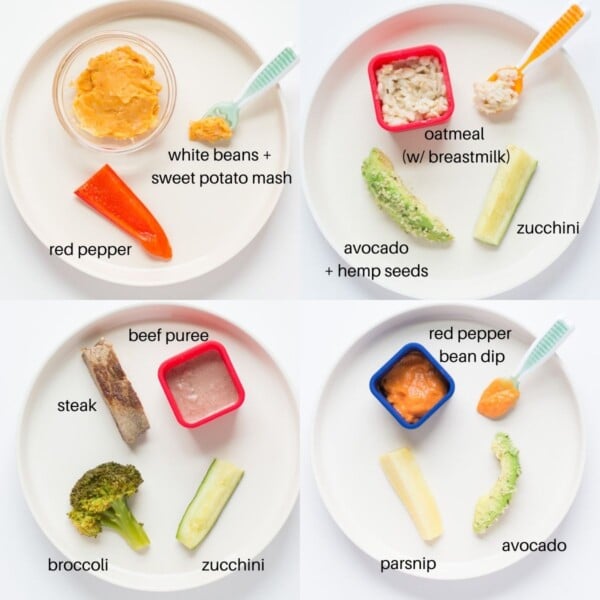









Thank you!
You’re welcome!
Hi MJ, thanks for this informative article. I know you mentioned here to enjoy in moderation but still quite concerned about its sodium level. Is it still ok to be served to babies around 6 to 7 months once or twice a week?
Hi Wendy! Yes, once or twice in a week is ok especially since not much will get eaten at that age, but I wouldn’t serve it every week